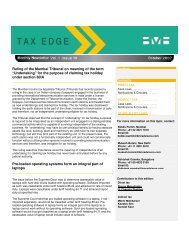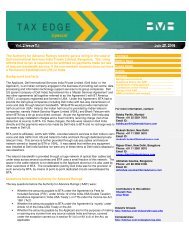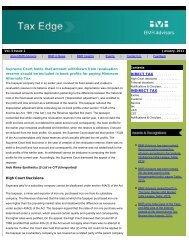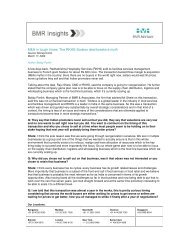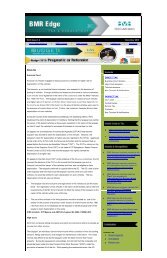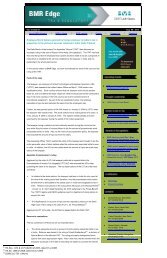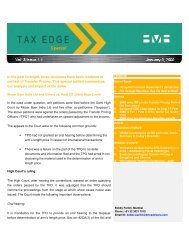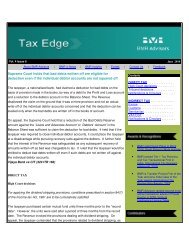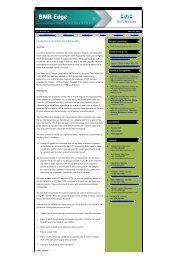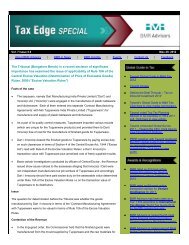Corporate Tax 2010 - BMR Advisors
Corporate Tax 2010 - BMR Advisors
Corporate Tax 2010 - BMR Advisors
Create successful ePaper yourself
Turn your PDF publications into a flip-book with our unique Google optimized e-Paper software.
Simpson Grierson<br />
New Zealand<br />
New Zealand<br />
resident in New Zealand that are controlled directly or indirectly by<br />
a single non-resident and branches of certain overseas companies.<br />
The rules operate by limiting interest deductions to a level<br />
consistent with a 75% New Zealand group debt percentage or 110%<br />
of worldwide group debt, whichever is the greater (see our answer<br />
to question 3.5). The thin capitalisation rules apply to interest on<br />
both associated and non-associated debt.<br />
A similar set of thin capitalisation rules will apply from the 2009-<br />
<strong>2010</strong> tax year to limit the interest deductions of New Zealand<br />
resident entities that directly or indirectly control non-resident<br />
companies (“CFCs”). These rules have been introduced in<br />
conjunction with the introduction of an exemption for active<br />
income derived by New Zealand residents from interests in CFCs,<br />
and are intended to limit the extent to which New Zealand groups<br />
can bias the allocation of their interest costs to New Zealand.<br />
Note that there is a different set of thin capitalisation rules for<br />
foreign-owned registered banks.<br />
4 <strong>Tax</strong> on Business Operations: General<br />
4.1 What is the headline rate of tax on corporate profits<br />
The headline rate of tax on company profits is currently 30%.<br />
4.2 When is that tax generally payable<br />
New Zealand companies are generally required to pay income tax<br />
in three equal “provisional tax” instalments. The instalment dates<br />
are based on the company’s income year. For a standard income<br />
year, which ends on 31 March, the instalment dates are 28 August<br />
and 15 January of the relevant income year and 7 May of the<br />
following income year. The amount of provisional tax is generally<br />
calculated based on either an estimate of the company’s income, or<br />
an uplift of 5% of tax payable for the previous income year.<br />
3.5 If so, is there a “safe harbour” by reference to which tax<br />
relief is assured<br />
Yes. The thin capitalisation rules provide a safe harbour in which<br />
interest deductions for a New Zealand group are allowed to the<br />
extent its New Zealand group debt percentage (broadly New<br />
Zealand group debt as a percentage of New Zealand group assets)<br />
does not exceed the greater of 75%, or 110% of the debt percentage<br />
of the worldwide group. The thin capitalisation rules also contain<br />
an on-lending concession in calculating the debt percentages.<br />
The different thin capitalisation rules that apply for foreign owned<br />
registered banks are triggered where New Zealand group equity is<br />
below 4% of risk weighted assets.<br />
3.6 Would any such “thin capitalisation” rules extend to debt<br />
advanced by a third party but guaranteed by a parent<br />
company<br />
Yes. There is no exception to the thin capitalisation rules for debt<br />
advanced by third parties. See our answer to question 3.4.<br />
3.7 Are there any restrictions on tax relief for interest<br />
payments by a local company to a non-resident in addition<br />
to any thin capitalisation rules mentioned in questions<br />
3.4-3.6 above<br />
Yes. If the debt funding was provided by a non-resident associated<br />
person and was greater than an “arm’s-length” amount, the transferpricing<br />
rules could limit the New Zealand borrower’s interest<br />
deduction.<br />
3.8 Does New Zealand have transfer pricing rules<br />
4.3 What is the tax base for that tax (profits pursuant to<br />
commercial accounts subject to adjustments; other tax<br />
base)<br />
New Zealand income tax is calculated on a gross/global basis,<br />
meaning that for tax purposes net income (or loss) is calculated as<br />
total “assessable income” less total “deductions” - these concepts<br />
are extensively defined in the income tax rules. Therefore, in<br />
principle, New Zealand does not impose tax based on commercial<br />
accounts (especially in relation to deductions). However, in many<br />
areas commercial accounting rules correspond to tax rules, so in<br />
practice a company’s net income (or loss) is most commonly<br />
calculated by making adjustments to commercial accounts.<br />
4.4 If it otherwise differs from the profit shown in commercial<br />
accounts, what are the main other differences<br />
Significant differences between the profit in commercial accounts<br />
and taxable income are likely to arise from:<br />
depreciation deductions which are based on tax depreciation<br />
rates that do not follow commercial accounts;<br />
financial arrangements rules (applying to debt and debt<br />
substitutes), which may deny deductions for credit<br />
impairment adjustments, may include in assessable income<br />
amounts allocated to equity for accounting purposes, and in<br />
some cases may not follow commercial accounting rules at<br />
all;<br />
capital gains treated differently for commercial accounting<br />
and income tax; and<br />
impairments to goodwill or revaluations of assets.<br />
4.5 Are there any tax grouping rules Do these allow for relief<br />
in New Zealand for losses of overseas subsidiaries<br />
176<br />
Yes. Transfer pricing rules apply (with a number of exceptions)<br />
where amounts paid by local entities to associated non-New<br />
Zealand residents exceed an arm’s length consideration, and where<br />
amounts received by local entities from associated non-New<br />
Zealand residents are less than an arm’s length consideration. It is<br />
possible to apply to the Inland Revenue Department for an<br />
“advance pricing agreement” which approves transfer prices in<br />
advance.<br />
Yes, there are tax grouping rules. Broadly, loss offsets (and/or<br />
subvention payments, where a profit company makes a deductible<br />
payment to a loss company) are permitted between companies that<br />
satisfy a 66% common ownership threshold from the time at which<br />
the relevant losses were incurred by the loss company, to the time<br />
at which they are to be offset (or subvented) to the profit company.<br />
The loss grouping rules do not allow relief in New Zealand for<br />
losses of overseas subsidiaries. The rules require that the loss<br />
company is either incorporated, or carries on business through a<br />
fixed establishment, in New Zealand. Further, if the loss company<br />
is a New Zealand resident company, its losses cannot be offset<br />
WWW.ICLG.CO.UK<br />
ICLG TO: CORPORATE TAX <strong>2010</strong><br />
© Published and reproduced with kind permission by Global Legal Group Ltd, London







